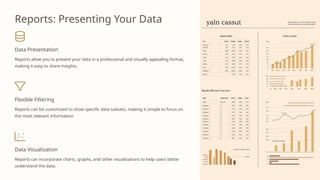Microsoft-Access-An-Introduction to Database
- 1. Microsoft Access: An Introduction Microsoft Access is a powerful database management system that allows you to organize, store, and manage your data in a structured and efficient manner. It provides a user-friendly interface for creating tables, queries, forms, and reports to help you make sense of your information. by Deandra Murray
- 2. What is Microsoft Access? Relational Database Access is a relational database management system, which means it stores data in interconnected tables that can be accessed and manipulated in various ways. User-Friendly Interface The Access interface is designed to be intuitive and easy to use, even for those with limited database experience. Versatile Applications Access can be used to create a wide range of applications, from simple personal databases to complex enterprise-level solutions.
- 3. Tables: The Building Blocks of Access 1 Organize Data Tables in Access are where you store your data, with each table containing a specific set of related information. 2 Define Structure Tables have fields (columns) that define the types of data you can store, and records (rows) that represent individual data entries. 3 Maintain Integrity Tables help ensure data integrity by enforcing rules and relationships, preventing duplicates, and ensuring data consistency.
- 4. Queries: Extracting and Analyzing Data Retrieve Data Queries allow you to retrieve specific data from your tables, based on defined criteria and conditions. Analyze Information Queries can be used to perform calculations, apply filters, and combine data from multiple tables to gain insights. Automate Tasks Queries can be saved and reused, making it easy to repeat complex data extraction and analysis tasks.
- 5. Relationships: Connecting Your Data 1 One-to-Many A common relationship type where one record in a table can be linked to multiple records in another table. 2 Many-to-Many A complex relationship where multiple records in one table can be linked to multiple records in another table. 3 One-to-One A less common relationship where one record in a table is uniquely linked to one record in another table.
- 6. Reports: Presenting Your Data Data Presentation Reports allow you to present your data in a professional and visually appealing format, making it easy to share insights. Flexible Filtering Reports can be customized to show specific data subsets, making it simple to focus on the most relevant information. Data Visualization Reports can incorporate charts, graphs, and other visualizations to help users better understand the data.
- 7. Forms: Interacting with Your Data User-Friendly Interface Forms provide a user-friendly way for people to interact with the data in your database, making data entry and retrieval easy. Data Validation Forms can be designed to enforce data validation rules, ensuring that users input accurate and consistent information. Streamlined Workflows Forms can be used to automate and streamline common tasks, such as data entry, record updates, and reporting.
- 8. Macros: Automating Tasks in Access Task Automation Macros allow you to automate repetitive tasks, such as opening forms, running reports, or performing data manipulations. Event-Driven Triggers Macros can be set to run in response to specific events, like opening a database or clicking a button. Efficiency Boost By automating common tasks, macros can help you save time and reduce the risk of human error.
- 9. Security and Permissions in Access 1 User Accounts Access allows you to create user accounts with different levels of permissions, ensuring data security and privacy. 2 Permissions Management You can control which users can view, edit, or delete data, as well as who can access specific database objects. 3 Audit Logging Access provides logging capabilities to track user activities, making it easier to monitor and maintain data integrity.
- 10. Best Practices for Effective Access Management Data Modeling Carefully plan your database structure to ensure data integrity, scalability, and ease of maintenance. Regular Backups Regularly back up your database to protect against data loss and ensure business continuity. Documentation Create detailed documentation to help users understand the database structure and functionality.









